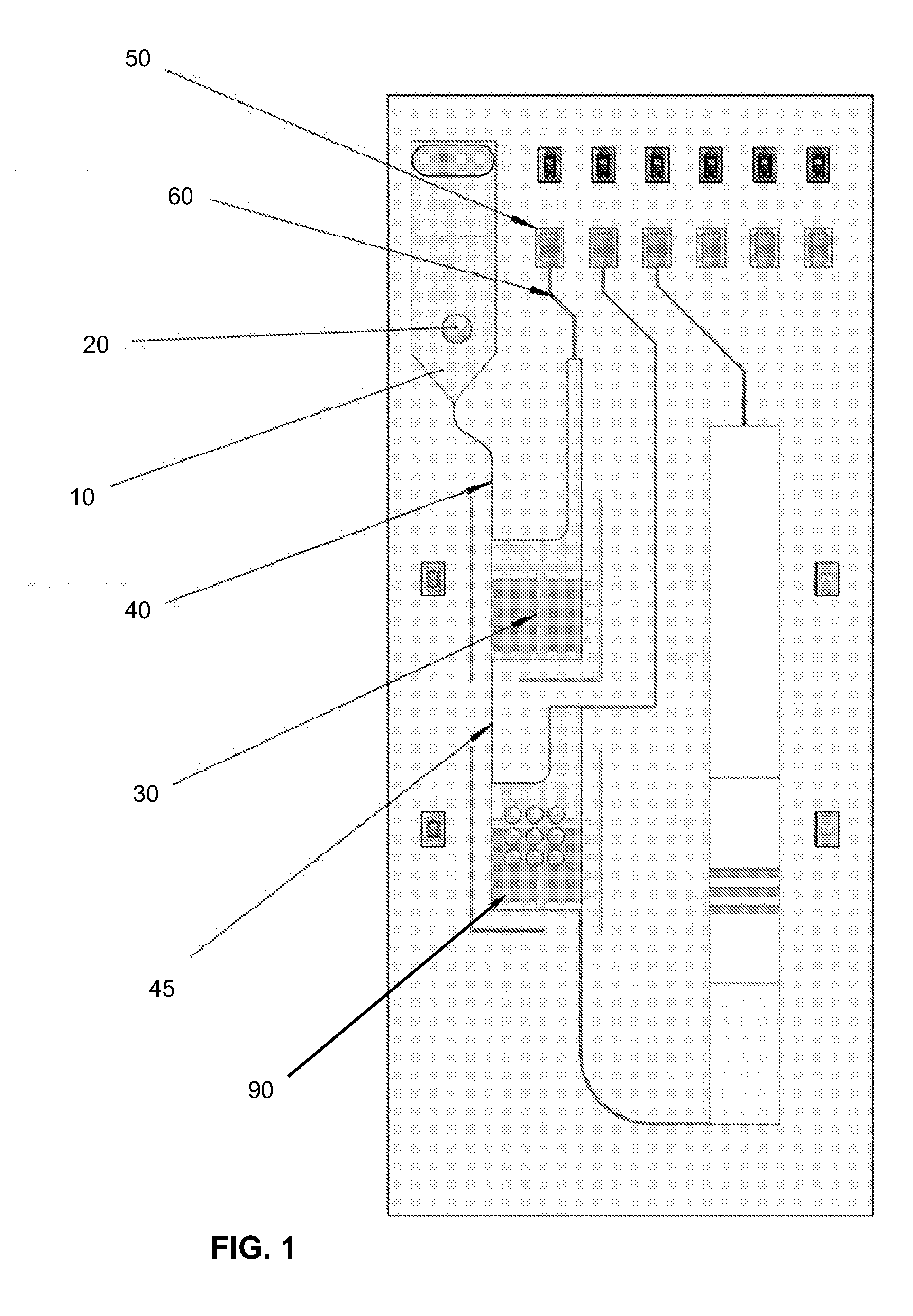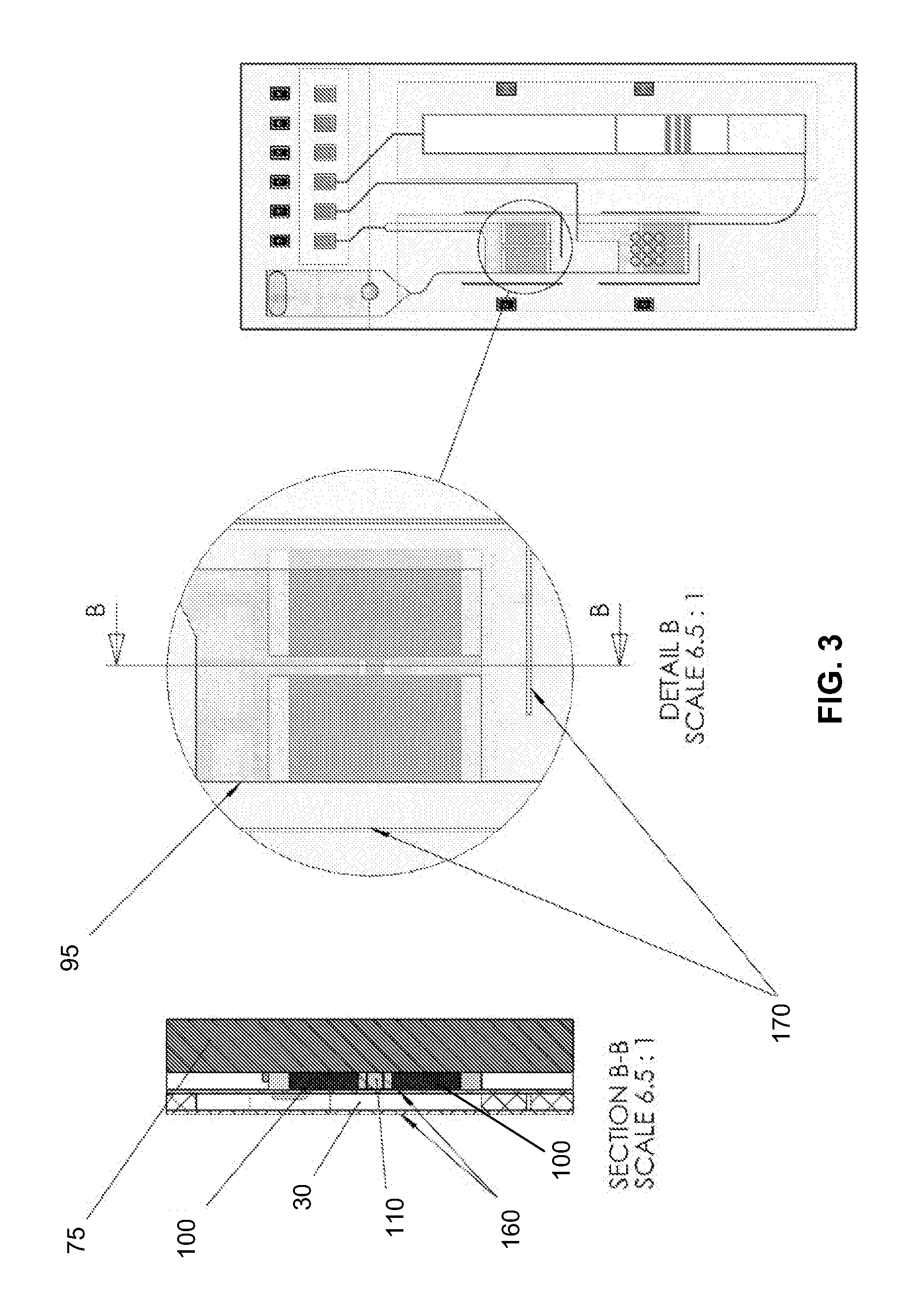Integrated device for nucleic acid detection and identification
- Summary
- Abstract
- Description
- Claims
- Application Information
AI Technical Summary
Benefits of technology
Problems solved by technology
Method used
Image
Examples
example 1
Method of Amplification and Detection of a Target Nucleic Acid for the Diagnosis of Candidatus Liberibacter Infection in Citrus
[0097]An embodiment of the invention wherein a disposable component interfaces with a reusable dock was employed to test citrus leaf tissue for the presence of Candidatus Liberibacter asiaticus, the etiologic agent of citrus greening.
[0098]A partially disposable device as described above was constructed. The reusable unit comprised a standard 1.5 oz copper-clad PCB. Circuit components included an ATmega328 microcontroller, 0.5 Amp N-channel MOSFETs, SMD resistors, and power conditioning components. A stereolithography (SLA) formed plastic shell covered the board and tactile switches. A female pin connector was mounted to the top surface to allow for a vertical connection to the disposable PCA. The disposable PCA comprised a similar PCB along with thick-film resistors, 0402 thermistor, and 0603 LEDs. A right angle male pin connector was placed one end of the ...
example 2
Method of Isolation, Amplification, and Detection of a Target Nucleic Acid for the Diagnosis of Candidatus Liberibacter Infection in Citrus
[0116]A partially disposable device as described above was constructed. The reusable unit comprised a standard 1.5 oz copper-clad PCB. Circuit components included an ATmega328 microcontroller, 0.5 Amp N-channel MOSFETs, SMD resistors, and power conditioning components. A stereolithography (SLA) formed plastic shell covers the board and tactile switches. A female pin connector was mounted to the top surface to allow for a vertical connection to the disposable PCA. The disposable PCA comprised a similar PCB along with thick-film resistors, 0402 thermistor, and 0603 LEDs. A right angle male pin connector was placed at one end of the board to provide vertical orientation when inserted into the female socket of the reusable unit.
[0117]The fluidic layer comprised two face components, a wall component, and a thin membrane. Face components comprised 0.00...
example 3
Method of Amplification and Detection of a Target Nucleic Acid for the Diagnosis of Candidatus Liberibacter Infection in Citrus
[0132]An embodiment of the invention wherein a disposable component interfaces with a reusable dock was employed to test crude citrus leaf tissue extracts for the presence of Candidatus Liberibacter asiaticus, the etiologic agent of citrus greening without a preceding nucleic acid isolation step.
[0133]A partially disposable device as described above was constructed. The reusable unit comprised a standard 1.5 oz copper-clad PCB. Circuit components included an ATmega328 microcontroller, 0.5 Amp N-channel MOSFETs, SMD resistors, and power conditioning components. A stereolithography (SLA) formed plastic shell covered the board and tactile switches. A female pin connector was mounted to the top surface to allow for a vertical connection to the disposable PCA. The disposable PCA comprised a similar PCB along with thick-film resistors, 0402 thermistor, and 0603 LE...
PUM
| Property | Measurement | Unit |
|---|---|---|
| Volume | aaaaa | aaaaa |
| Volume | aaaaa | aaaaa |
| Dimension | aaaaa | aaaaa |
Abstract
Description
Claims
Application Information
 Login to View More
Login to View More - Generate Ideas
- Intellectual Property
- Life Sciences
- Materials
- Tech Scout
- Unparalleled Data Quality
- Higher Quality Content
- 60% Fewer Hallucinations
Browse by: Latest US Patents, China's latest patents, Technical Efficacy Thesaurus, Application Domain, Technology Topic, Popular Technical Reports.
© 2025 PatSnap. All rights reserved.Legal|Privacy policy|Modern Slavery Act Transparency Statement|Sitemap|About US| Contact US: help@patsnap.com



